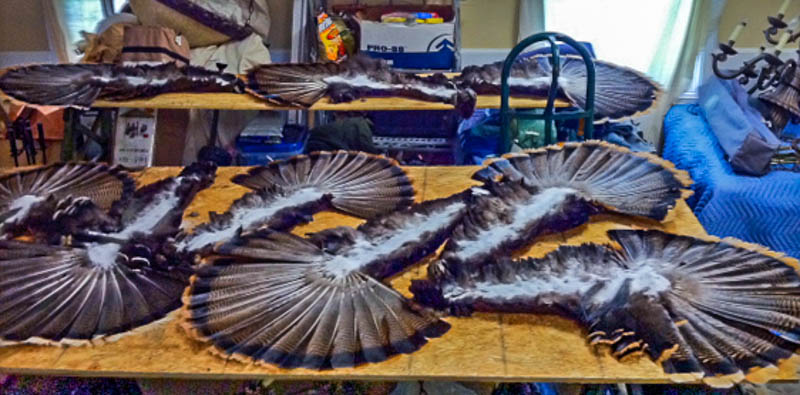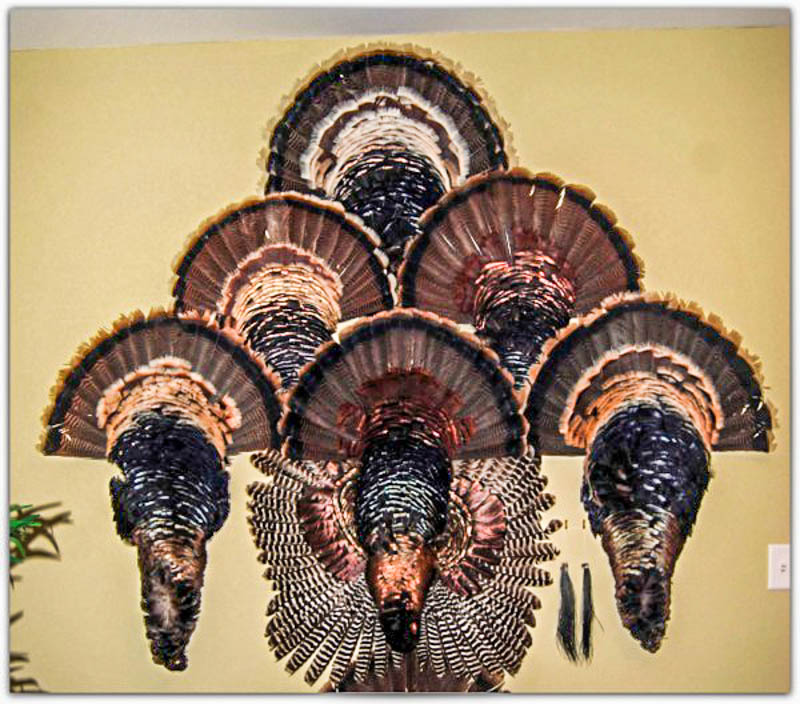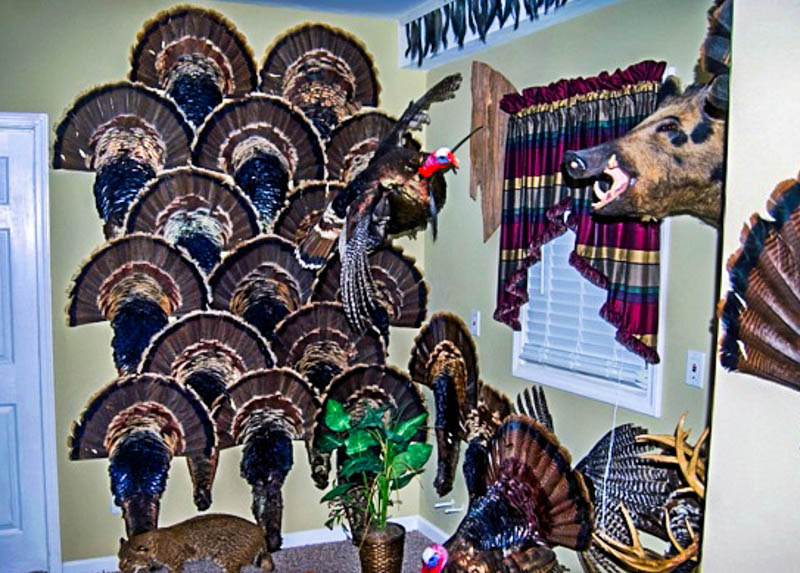Caping out a turkey and preparing it for display is simple to do and takes very little time. It makes a great display and there’s virtually no cost or kits to order, no plaques to make and no taxidermist bill to pay.
Once you’ve done one it takes no more than 10 minutes to cape a turkey out in the field and prepare it for transport. It takes about the same amount of time to prepare, stretch, and tack it down on a board, and borax the bird once the season is over and you pull it out of the freezer.
This “How to Cape a Turkey” write up along with the video that GSN has provided will make it easier for those who want to cape their birds.
Caping your turkey in the field
- Handle the bird carefully once you’ve harvested him. Be careful not to damage feathers or the fan when carrying him back to camp. The better shape he’s in – the better cape you’ll have.
- For easier caping clip the wings off.
- Hang the bird by his head and neck. This can be done from limbs or even the side rail of your truck. (Note: This entire process is easier if there’s someone to hold the bird still while you cape. I’ve done numerous ones alone but not trying to cape a pinwheel helps.)
- You will notice a distinguishable parting of feathers starting at the neck and extending down the side of the bird all the way to his fan. It’s similar to a human hair / part line. The key is to follow this line when cutting the cape off the bird. This is narrow on the neck and gets progressively wider as you get closer to the wing.
Make your first cut on the back of the bird’s neck where the feathers meet the hairless skin near the head and begin to follow the part line down the bird. Cut a few inches on each side to get started. Be careful to not pull feathers loose and as soon as the skin is exposed grip this instead to the outer part of the cape. This avoids pulling feathers loose that could affect the look of the finished cape. Once you get away from the head, slip your fingers tips in behind the skin and pull while you cut and follow the line. If in doubt where the line is go wider towards the clipped wing bone area. I usually make this cut all the way down to the bird’s leg and then do the same on the opposite side.
- After the side cuts are complete, grip the cape from the inside and begin to pull and trim the cape away from the bird. Often the skin will separate similar to skinning a deer but be careful to not over do it. As you approach the mid back region the skin is very thin and you have to be careful not to cut thru the skin. You’ll understand this better once you’ve done one. Don’t worry if you have a couple “cut throughs” as it will likely not show up from the outside of the cape. After clearing the mid back the cape will pull loose for a couple inches and then you’ll have to trim again.
- Once you trim the cape down to the fan area, finish the cuts on each side near the legs so that the entire cape is below the section at the fan. You’ll be able to grip the same place that you would normally just cut the fan loose and cut it free. The fan and cape should be in one piece and the caping is now complete.
- To prepare for transport simply place a paper towel or toilet paper along the area against the exposed skin and fold it over. Place it in a bag and its ready for the freezer. If traveling its good to have an oversized “carry on” bag that you can pack the cape in. I have packed as many as 6 capes in a piece of luggage. If you’re on a travel hunt and a freezer isn’t available, spread the cape and borax it until its time to pack up and travel. (A word of advice here is that if you do borax the bird, try and finish the caping process sooner rather than later once you are home. I have had birds began to cure out while still in the freezer making it difficult to prepare and stretch compared to a bird that was not boraxed.)
The field aspect is now completed and once back home simply place it in the freezer until the season is over and you have time to finish the process.
Turkey capes can be made into arrangements to maximize space
Preparing the Cape for Curing at Home
Tools Needed: Small snips or shears, knife, scissors, hammer, 4 d nails, 6 d nails, board or plywood strips, borax (Mule Team 20 20 can be found in most grocery stores)
- Remove the bird from the freezer and allow to thaw. I lay mine out in the truck bed or driveway and within a couple hours they will unfold and I can begin the finishing process.
- Flip the cape with feathers down and grasp group of feathers behind the main fan quills. Cut away with scissors. Press down on fan and hold knife flat and trim away meat where the main quills come together. Cut all meat away until all you see is the yellow near the quill tips. This is easy once you’ve done one and it can be done in one cut with experience. Cut both sides away and you’ll feel a small section of bone that protrudes up off quills. Use your snips and clip this away. Again press flat to quills and be careful where you cut.
- Often when you cape you’ll have a couple secondary skin and feather sections that need to be cut away. Theses can be left but I prefer to get rid of them for the shape I like. By carefully holding them above the main cape you can clip these off with scissors. Now check the cape itself and careful cut away any meat that may be on the cape from the original field caping. Now the cape is ready to be stretched and prepared for curing.
- Lay the cape on a board, strip of plywood, or sheet of plywood. (Its possible that heavy cardboard can be used as well but I like the stiffness wood provides.) Drive a 6 d nail through the middle of the fan where the quills come together (same area you cut the meat away and clipped the bone). Grasp the top of the neck section of the cape and pull tight and drive another 6 d nail to keep it in place.
- Drive 3 sets of 4 d nails to open and stretch the cape itself beginning near the fan and working your way to the neck area. You won’t stretch to the point of putting pressure on the cape but just firmly open it up and tack it down. 3 sets spread out should be adequate to help the cape take the proper shape. (Note: Don’t over drive nails. Tack just enough to hold so that they’re easy to remove later)
- Open the fan up so that’s it’s in alignment with the cape and adjust the fan to run straight across. It will permanently take the shape you give it so if it’s not all the way open or open too much that’s what you’ll end up with. Again, sight it so the base is straight across and tack a 4 d nail near the center quill area to hold in place. Adjust the feathers so that no openings between feathers are visible. Tack enough nails between feathers to be sure the spread will stay intact. I average using 6 nails to be safe.
- Pour borax to cover all exposed areas of the cape. Pour generously on the fan. Take the beard from the bird and “plug” it into the poured borax and it will cure along with the cape and it keeps the right beard with the right cape.

Caping a turkey for display Photo shows capes tacked down and curing
Store the cape in a safe area from children, pets, and weather. Let cure for 5 weeks and then simply remove by pulling nails with pliers. I dump most of the borax into a container and then carry outside and walk into the wind and tap with a bristle brush and lightly scape and brush the excess borax off. Be careful not to breathe it in and wearing a dust mask is advisable. I tap the cape from behind as well to clear as much as possible.
- To mount the cape is easy. Lay feathers up, grasp the fan and determine approximate center of fan where quills meet. Drive a 6 or 8 d nail through the cape until the nail comes out the skin side. Hold the cape on the wall and tap the nail until it’s mounted on the wall. Avoid studs as just the drywall penetration will hold..
This is all it takes to skin and prepare a cape for mounting. Although several steps are involved from a time standpoint it only takes 20 minutes a cape for the combined aspects once you’ve done a couple.
Hopefully this piece along with the 2 videos will be helpful for those that would like to cape their birds.

Bobby Parks
Grand Slam Network
Ol Tom Field Expert
Mossy Oak Pro Staff
